Professional Development Plan and HR Skills Report - University Name
VerifiedAdded on 2020/04/21
|10
|2781
|248
Report
AI Summary
This report, focusing on professional development within Human Resources Management, explores the essential skills required for HR professionals. The author discusses the importance of organizational, multitasking, negotiation, and communication skills, as well as discretion and ethical conduct. The report reflects on the author's learning experiences, including a business pitch assignment, and how these experiences fostered teamwork, communication, and conflict resolution skills. A personal development plan (PDP) is outlined, detailing objectives, resources, activities, and targets for individual and professional growth. The report identifies key attributes for success in HR, such as decisiveness, influence, and collaboration, and discusses the 70-20-10 rule for skill development. Methods like education, training, and on-the-job experiences are explored, including activities like filling in for supervisors, managing projects, and seeking feedback. The report concludes with planned activities to enhance professional development, such as assisting supervisors, reviewing development plans, and seeking feedback for future improvements.
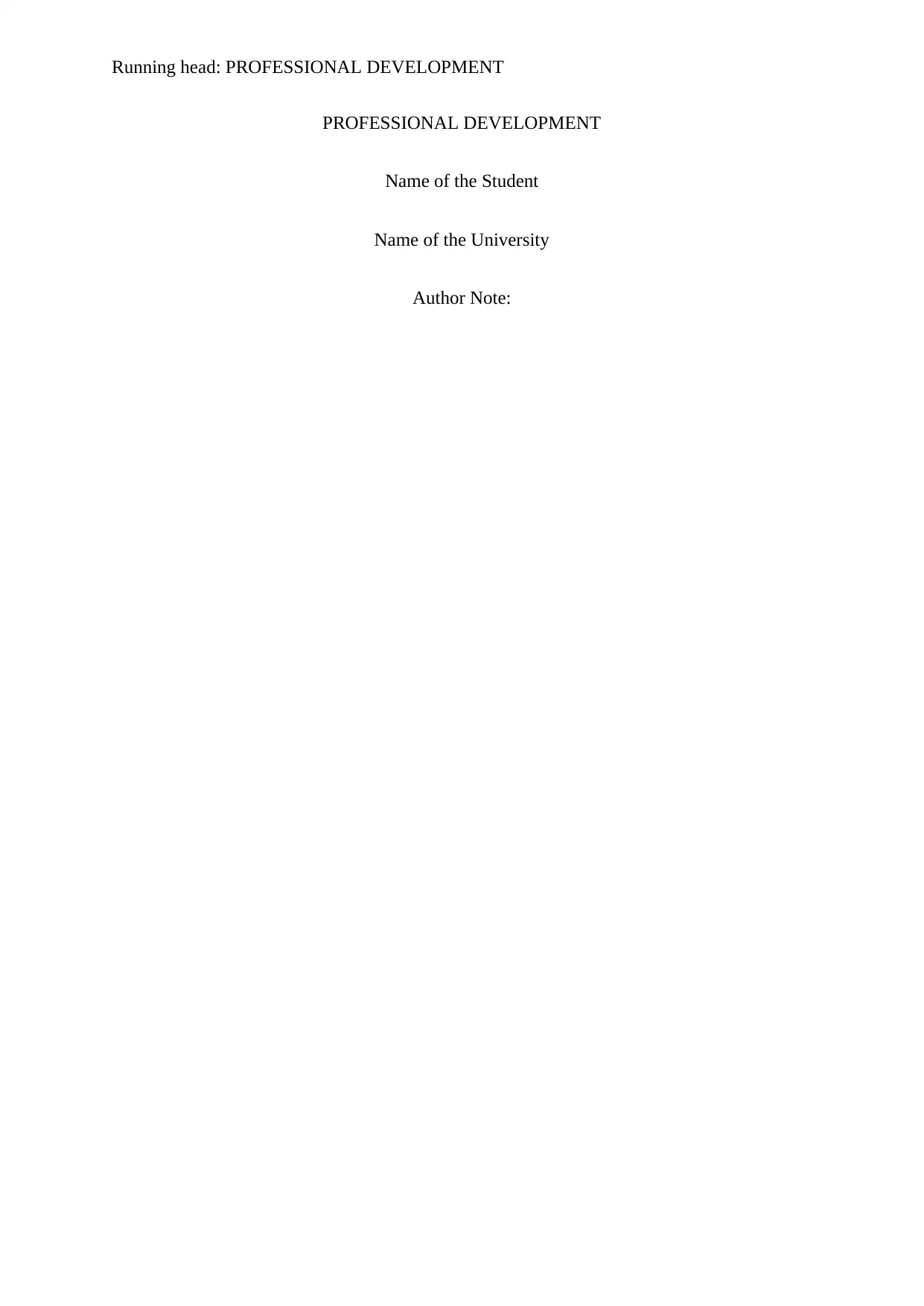
Running head: PROFESSIONAL DEVELOPMENT
PROFESSIONAL DEVELOPMENT
Name of the Student
Name of the University
Author Note:
PROFESSIONAL DEVELOPMENT
Name of the Student
Name of the University
Author Note:
Paraphrase This Document
Need a fresh take? Get an instant paraphrase of this document with our AI Paraphraser
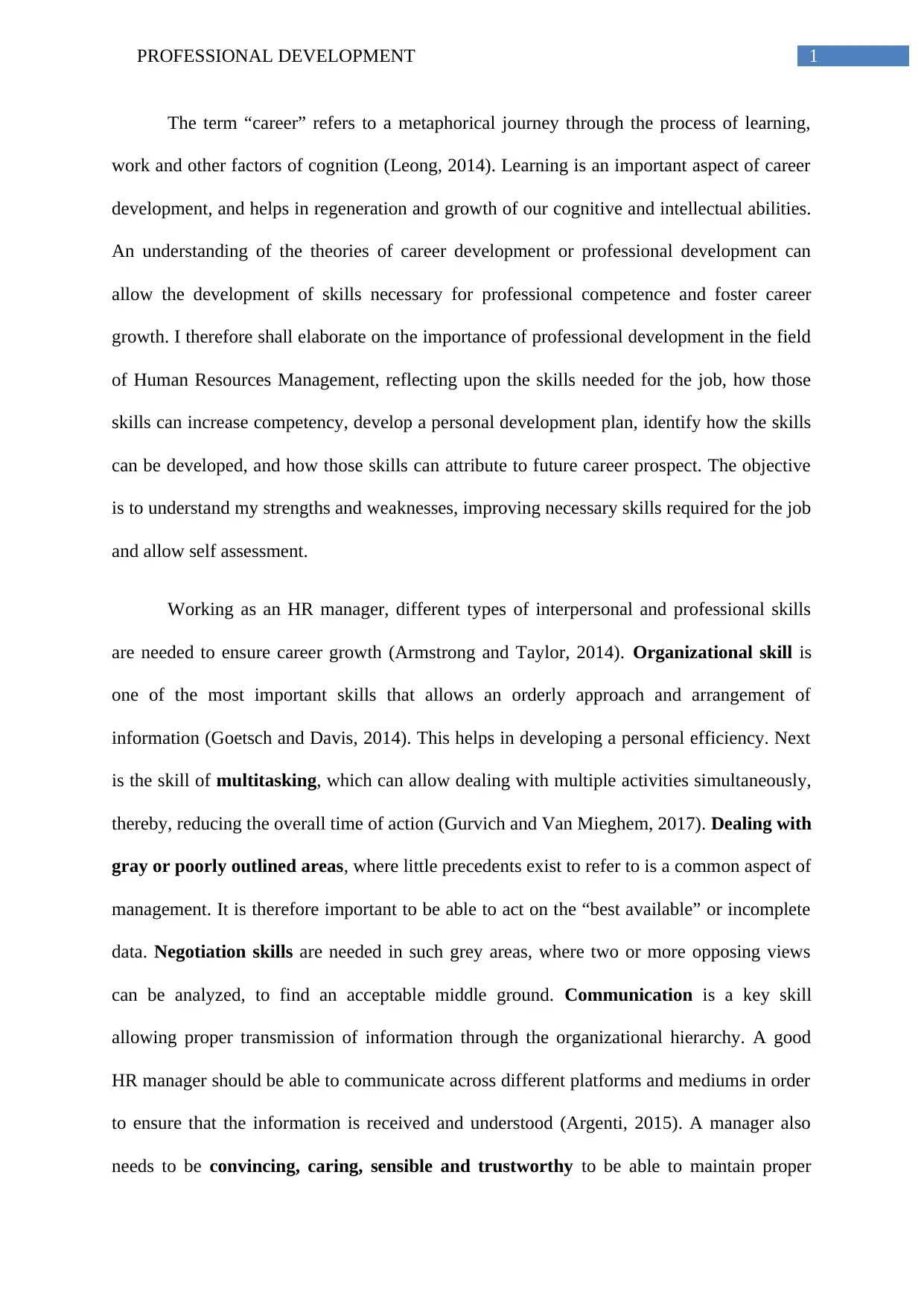
1PROFESSIONAL DEVELOPMENT
The term “career” refers to a metaphorical journey through the process of learning,
work and other factors of cognition (Leong, 2014). Learning is an important aspect of career
development, and helps in regeneration and growth of our cognitive and intellectual abilities.
An understanding of the theories of career development or professional development can
allow the development of skills necessary for professional competence and foster career
growth. I therefore shall elaborate on the importance of professional development in the field
of Human Resources Management, reflecting upon the skills needed for the job, how those
skills can increase competency, develop a personal development plan, identify how the skills
can be developed, and how those skills can attribute to future career prospect. The objective
is to understand my strengths and weaknesses, improving necessary skills required for the job
and allow self assessment.
Working as an HR manager, different types of interpersonal and professional skills
are needed to ensure career growth (Armstrong and Taylor, 2014). Organizational skill is
one of the most important skills that allows an orderly approach and arrangement of
information (Goetsch and Davis, 2014). This helps in developing a personal efficiency. Next
is the skill of multitasking, which can allow dealing with multiple activities simultaneously,
thereby, reducing the overall time of action (Gurvich and Van Mieghem, 2017). Dealing with
gray or poorly outlined areas, where little precedents exist to refer to is a common aspect of
management. It is therefore important to be able to act on the “best available” or incomplete
data. Negotiation skills are needed in such grey areas, where two or more opposing views
can be analyzed, to find an acceptable middle ground. Communication is a key skill
allowing proper transmission of information through the organizational hierarchy. A good
HR manager should be able to communicate across different platforms and mediums in order
to ensure that the information is received and understood (Argenti, 2015). A manager also
needs to be convincing, caring, sensible and trustworthy to be able to maintain proper
The term “career” refers to a metaphorical journey through the process of learning,
work and other factors of cognition (Leong, 2014). Learning is an important aspect of career
development, and helps in regeneration and growth of our cognitive and intellectual abilities.
An understanding of the theories of career development or professional development can
allow the development of skills necessary for professional competence and foster career
growth. I therefore shall elaborate on the importance of professional development in the field
of Human Resources Management, reflecting upon the skills needed for the job, how those
skills can increase competency, develop a personal development plan, identify how the skills
can be developed, and how those skills can attribute to future career prospect. The objective
is to understand my strengths and weaknesses, improving necessary skills required for the job
and allow self assessment.
Working as an HR manager, different types of interpersonal and professional skills
are needed to ensure career growth (Armstrong and Taylor, 2014). Organizational skill is
one of the most important skills that allows an orderly approach and arrangement of
information (Goetsch and Davis, 2014). This helps in developing a personal efficiency. Next
is the skill of multitasking, which can allow dealing with multiple activities simultaneously,
thereby, reducing the overall time of action (Gurvich and Van Mieghem, 2017). Dealing with
gray or poorly outlined areas, where little precedents exist to refer to is a common aspect of
management. It is therefore important to be able to act on the “best available” or incomplete
data. Negotiation skills are needed in such grey areas, where two or more opposing views
can be analyzed, to find an acceptable middle ground. Communication is a key skill
allowing proper transmission of information through the organizational hierarchy. A good
HR manager should be able to communicate across different platforms and mediums in order
to ensure that the information is received and understood (Argenti, 2015). A manager also
needs to be convincing, caring, sensible and trustworthy to be able to maintain proper
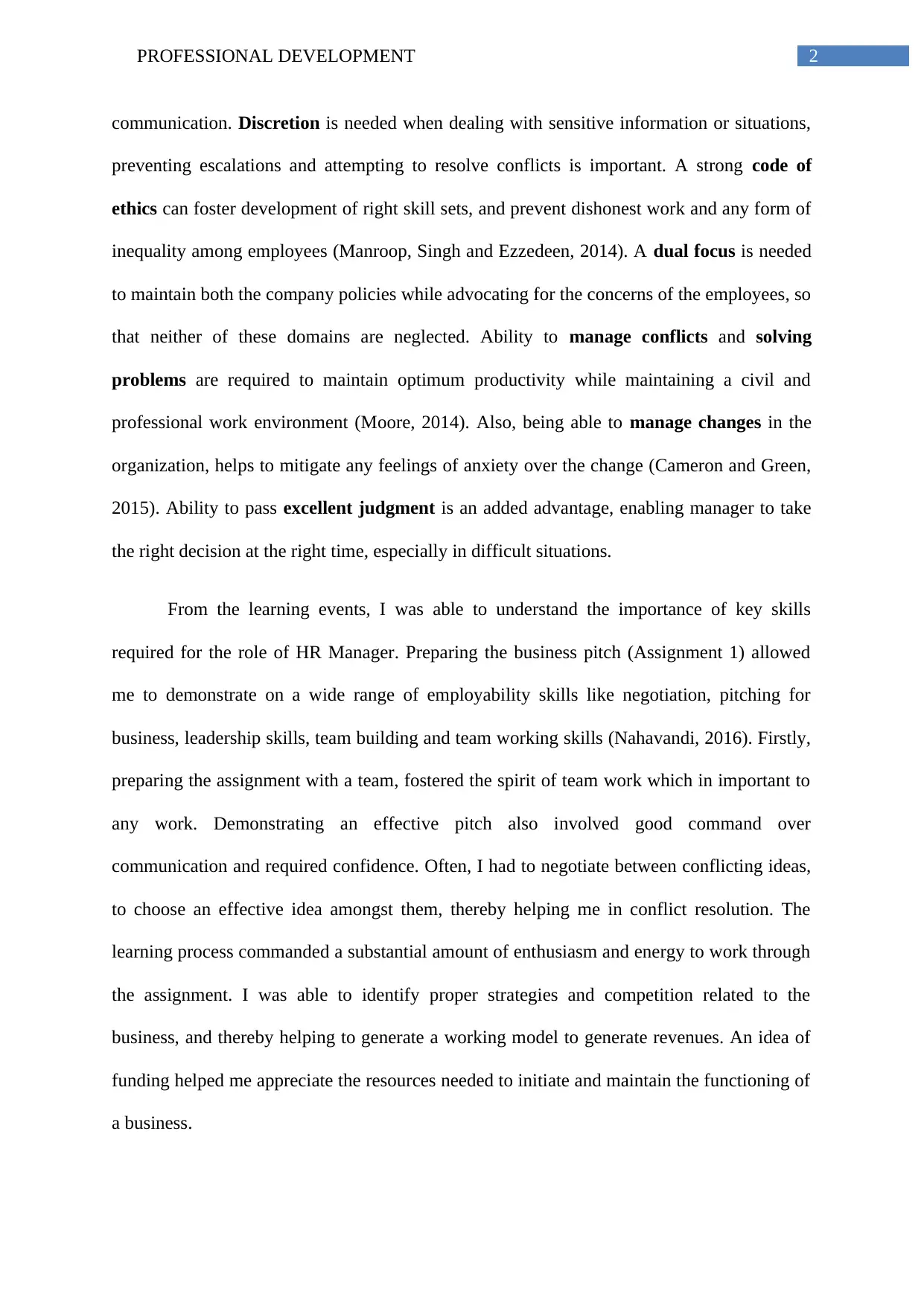
2PROFESSIONAL DEVELOPMENT
communication. Discretion is needed when dealing with sensitive information or situations,
preventing escalations and attempting to resolve conflicts is important. A strong code of
ethics can foster development of right skill sets, and prevent dishonest work and any form of
inequality among employees (Manroop, Singh and Ezzedeen, 2014). A dual focus is needed
to maintain both the company policies while advocating for the concerns of the employees, so
that neither of these domains are neglected. Ability to manage conflicts and solving
problems are required to maintain optimum productivity while maintaining a civil and
professional work environment (Moore, 2014). Also, being able to manage changes in the
organization, helps to mitigate any feelings of anxiety over the change (Cameron and Green,
2015). Ability to pass excellent judgment is an added advantage, enabling manager to take
the right decision at the right time, especially in difficult situations.
From the learning events, I was able to understand the importance of key skills
required for the role of HR Manager. Preparing the business pitch (Assignment 1) allowed
me to demonstrate on a wide range of employability skills like negotiation, pitching for
business, leadership skills, team building and team working skills (Nahavandi, 2016). Firstly,
preparing the assignment with a team, fostered the spirit of team work which in important to
any work. Demonstrating an effective pitch also involved good command over
communication and required confidence. Often, I had to negotiate between conflicting ideas,
to choose an effective idea amongst them, thereby helping me in conflict resolution. The
learning process commanded a substantial amount of enthusiasm and energy to work through
the assignment. I was able to identify proper strategies and competition related to the
business, and thereby helping to generate a working model to generate revenues. An idea of
funding helped me appreciate the resources needed to initiate and maintain the functioning of
a business.
communication. Discretion is needed when dealing with sensitive information or situations,
preventing escalations and attempting to resolve conflicts is important. A strong code of
ethics can foster development of right skill sets, and prevent dishonest work and any form of
inequality among employees (Manroop, Singh and Ezzedeen, 2014). A dual focus is needed
to maintain both the company policies while advocating for the concerns of the employees, so
that neither of these domains are neglected. Ability to manage conflicts and solving
problems are required to maintain optimum productivity while maintaining a civil and
professional work environment (Moore, 2014). Also, being able to manage changes in the
organization, helps to mitigate any feelings of anxiety over the change (Cameron and Green,
2015). Ability to pass excellent judgment is an added advantage, enabling manager to take
the right decision at the right time, especially in difficult situations.
From the learning events, I was able to understand the importance of key skills
required for the role of HR Manager. Preparing the business pitch (Assignment 1) allowed
me to demonstrate on a wide range of employability skills like negotiation, pitching for
business, leadership skills, team building and team working skills (Nahavandi, 2016). Firstly,
preparing the assignment with a team, fostered the spirit of team work which in important to
any work. Demonstrating an effective pitch also involved good command over
communication and required confidence. Often, I had to negotiate between conflicting ideas,
to choose an effective idea amongst them, thereby helping me in conflict resolution. The
learning process commanded a substantial amount of enthusiasm and energy to work through
the assignment. I was able to identify proper strategies and competition related to the
business, and thereby helping to generate a working model to generate revenues. An idea of
funding helped me appreciate the resources needed to initiate and maintain the functioning of
a business.
⊘ This is a preview!⊘
Do you want full access?
Subscribe today to unlock all pages.

Trusted by 1+ million students worldwide
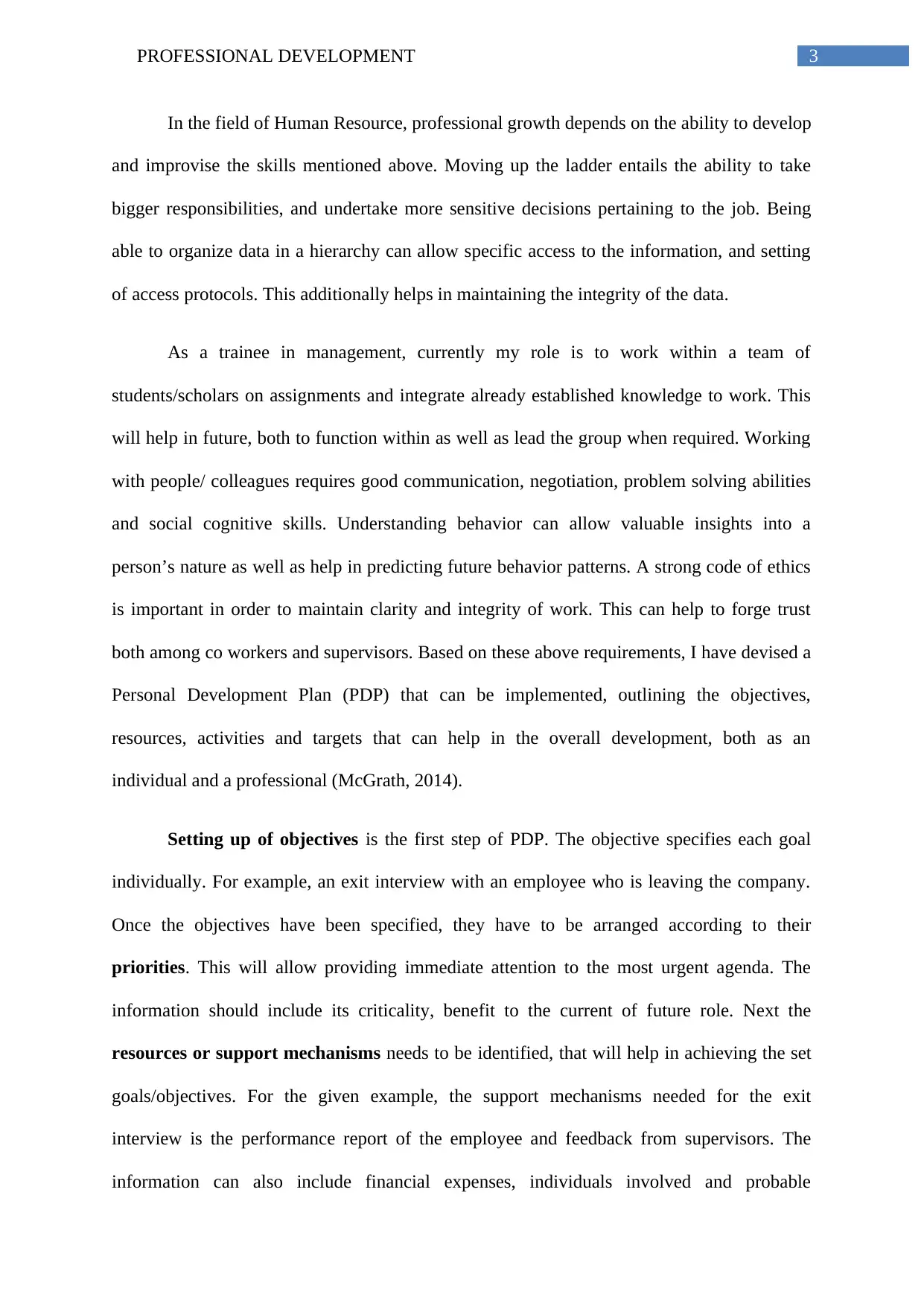
3PROFESSIONAL DEVELOPMENT
In the field of Human Resource, professional growth depends on the ability to develop
and improvise the skills mentioned above. Moving up the ladder entails the ability to take
bigger responsibilities, and undertake more sensitive decisions pertaining to the job. Being
able to organize data in a hierarchy can allow specific access to the information, and setting
of access protocols. This additionally helps in maintaining the integrity of the data.
As a trainee in management, currently my role is to work within a team of
students/scholars on assignments and integrate already established knowledge to work. This
will help in future, both to function within as well as lead the group when required. Working
with people/ colleagues requires good communication, negotiation, problem solving abilities
and social cognitive skills. Understanding behavior can allow valuable insights into a
person’s nature as well as help in predicting future behavior patterns. A strong code of ethics
is important in order to maintain clarity and integrity of work. This can help to forge trust
both among co workers and supervisors. Based on these above requirements, I have devised a
Personal Development Plan (PDP) that can be implemented, outlining the objectives,
resources, activities and targets that can help in the overall development, both as an
individual and a professional (McGrath, 2014).
Setting up of objectives is the first step of PDP. The objective specifies each goal
individually. For example, an exit interview with an employee who is leaving the company.
Once the objectives have been specified, they have to be arranged according to their
priorities. This will allow providing immediate attention to the most urgent agenda. The
information should include its criticality, benefit to the current of future role. Next the
resources or support mechanisms needs to be identified, that will help in achieving the set
goals/objectives. For the given example, the support mechanisms needed for the exit
interview is the performance report of the employee and feedback from supervisors. The
information can also include financial expenses, individuals involved and probable
In the field of Human Resource, professional growth depends on the ability to develop
and improvise the skills mentioned above. Moving up the ladder entails the ability to take
bigger responsibilities, and undertake more sensitive decisions pertaining to the job. Being
able to organize data in a hierarchy can allow specific access to the information, and setting
of access protocols. This additionally helps in maintaining the integrity of the data.
As a trainee in management, currently my role is to work within a team of
students/scholars on assignments and integrate already established knowledge to work. This
will help in future, both to function within as well as lead the group when required. Working
with people/ colleagues requires good communication, negotiation, problem solving abilities
and social cognitive skills. Understanding behavior can allow valuable insights into a
person’s nature as well as help in predicting future behavior patterns. A strong code of ethics
is important in order to maintain clarity and integrity of work. This can help to forge trust
both among co workers and supervisors. Based on these above requirements, I have devised a
Personal Development Plan (PDP) that can be implemented, outlining the objectives,
resources, activities and targets that can help in the overall development, both as an
individual and a professional (McGrath, 2014).
Setting up of objectives is the first step of PDP. The objective specifies each goal
individually. For example, an exit interview with an employee who is leaving the company.
Once the objectives have been specified, they have to be arranged according to their
priorities. This will allow providing immediate attention to the most urgent agenda. The
information should include its criticality, benefit to the current of future role. Next the
resources or support mechanisms needs to be identified, that will help in achieving the set
goals/objectives. For the given example, the support mechanisms needed for the exit
interview is the performance report of the employee and feedback from supervisors. The
information can also include financial expenses, individuals involved and probable
Paraphrase This Document
Need a fresh take? Get an instant paraphrase of this document with our AI Paraphraser
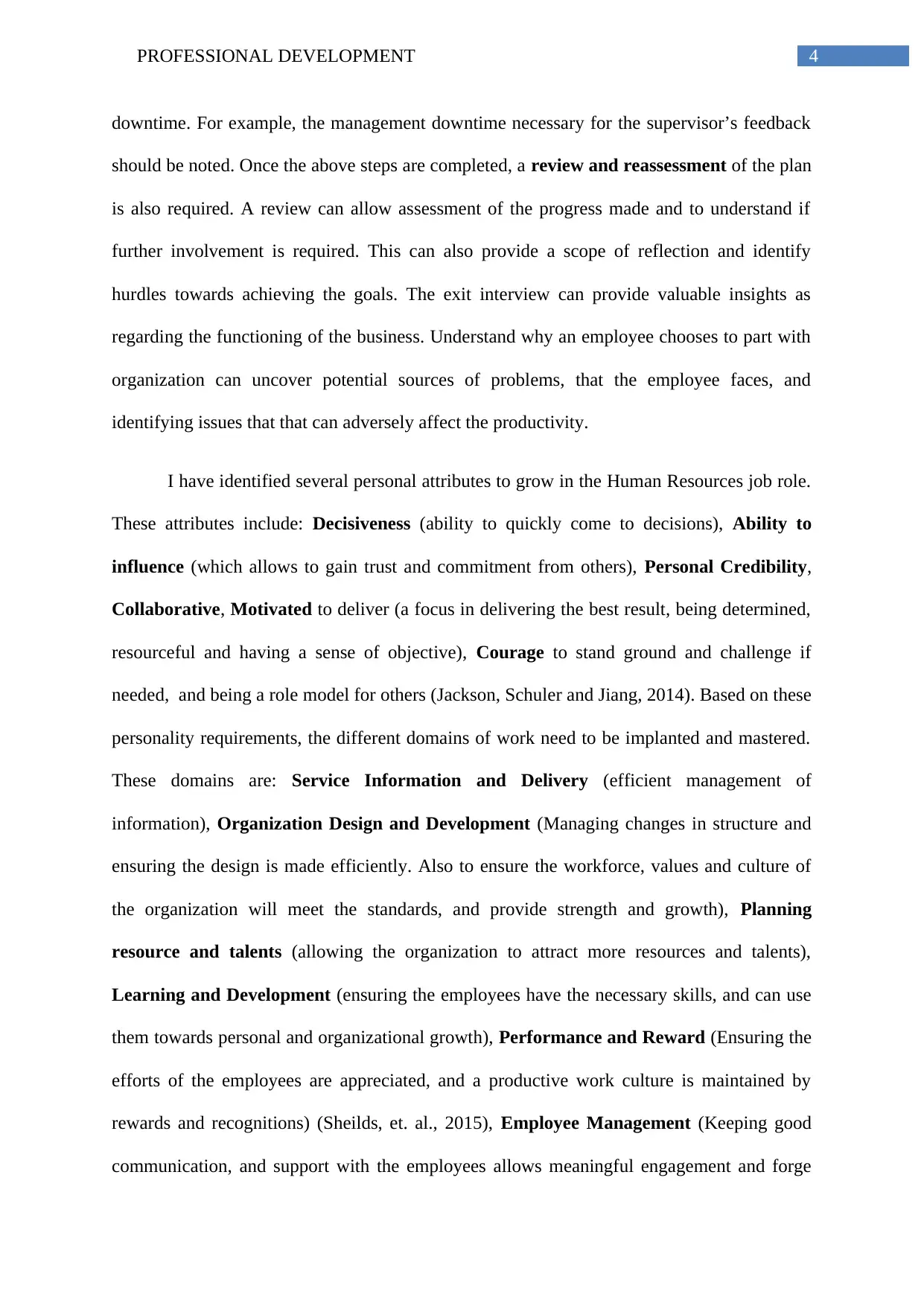
4PROFESSIONAL DEVELOPMENT
downtime. For example, the management downtime necessary for the supervisor’s feedback
should be noted. Once the above steps are completed, a review and reassessment of the plan
is also required. A review can allow assessment of the progress made and to understand if
further involvement is required. This can also provide a scope of reflection and identify
hurdles towards achieving the goals. The exit interview can provide valuable insights as
regarding the functioning of the business. Understand why an employee chooses to part with
organization can uncover potential sources of problems, that the employee faces, and
identifying issues that that can adversely affect the productivity.
I have identified several personal attributes to grow in the Human Resources job role.
These attributes include: Decisiveness (ability to quickly come to decisions), Ability to
influence (which allows to gain trust and commitment from others), Personal Credibility,
Collaborative, Motivated to deliver (a focus in delivering the best result, being determined,
resourceful and having a sense of objective), Courage to stand ground and challenge if
needed, and being a role model for others (Jackson, Schuler and Jiang, 2014). Based on these
personality requirements, the different domains of work need to be implanted and mastered.
These domains are: Service Information and Delivery (efficient management of
information), Organization Design and Development (Managing changes in structure and
ensuring the design is made efficiently. Also to ensure the workforce, values and culture of
the organization will meet the standards, and provide strength and growth), Planning
resource and talents (allowing the organization to attract more resources and talents),
Learning and Development (ensuring the employees have the necessary skills, and can use
them towards personal and organizational growth), Performance and Reward (Ensuring the
efforts of the employees are appreciated, and a productive work culture is maintained by
rewards and recognitions) (Sheilds, et. al., 2015), Employee Management (Keeping good
communication, and support with the employees allows meaningful engagement and forge
downtime. For example, the management downtime necessary for the supervisor’s feedback
should be noted. Once the above steps are completed, a review and reassessment of the plan
is also required. A review can allow assessment of the progress made and to understand if
further involvement is required. This can also provide a scope of reflection and identify
hurdles towards achieving the goals. The exit interview can provide valuable insights as
regarding the functioning of the business. Understand why an employee chooses to part with
organization can uncover potential sources of problems, that the employee faces, and
identifying issues that that can adversely affect the productivity.
I have identified several personal attributes to grow in the Human Resources job role.
These attributes include: Decisiveness (ability to quickly come to decisions), Ability to
influence (which allows to gain trust and commitment from others), Personal Credibility,
Collaborative, Motivated to deliver (a focus in delivering the best result, being determined,
resourceful and having a sense of objective), Courage to stand ground and challenge if
needed, and being a role model for others (Jackson, Schuler and Jiang, 2014). Based on these
personality requirements, the different domains of work need to be implanted and mastered.
These domains are: Service Information and Delivery (efficient management of
information), Organization Design and Development (Managing changes in structure and
ensuring the design is made efficiently. Also to ensure the workforce, values and culture of
the organization will meet the standards, and provide strength and growth), Planning
resource and talents (allowing the organization to attract more resources and talents),
Learning and Development (ensuring the employees have the necessary skills, and can use
them towards personal and organizational growth), Performance and Reward (Ensuring the
efforts of the employees are appreciated, and a productive work culture is maintained by
rewards and recognitions) (Sheilds, et. al., 2015), Employee Management (Keeping good
communication, and support with the employees allows meaningful engagement and forge
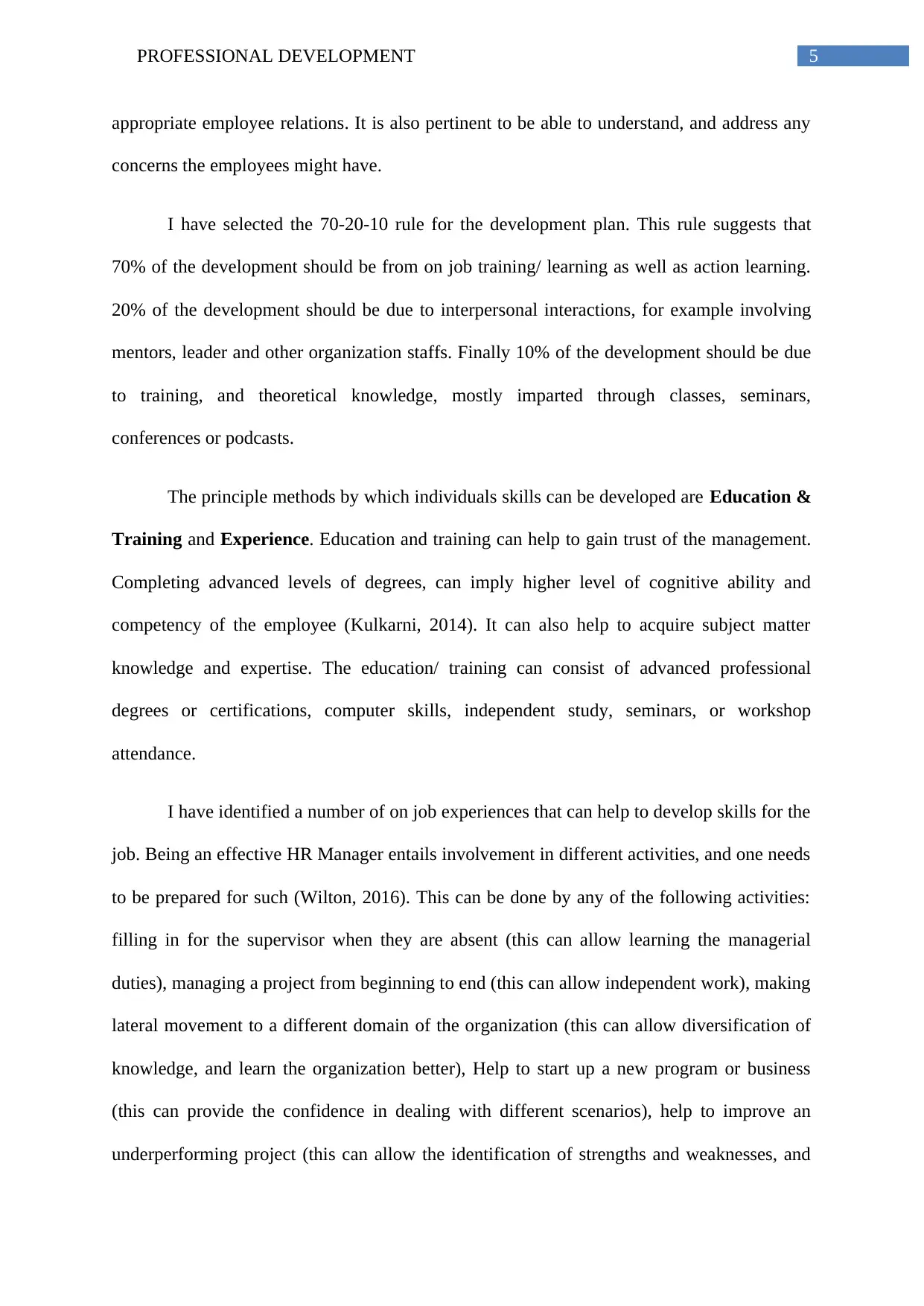
5PROFESSIONAL DEVELOPMENT
appropriate employee relations. It is also pertinent to be able to understand, and address any
concerns the employees might have.
I have selected the 70-20-10 rule for the development plan. This rule suggests that
70% of the development should be from on job training/ learning as well as action learning.
20% of the development should be due to interpersonal interactions, for example involving
mentors, leader and other organization staffs. Finally 10% of the development should be due
to training, and theoretical knowledge, mostly imparted through classes, seminars,
conferences or podcasts.
The principle methods by which individuals skills can be developed are Education &
Training and Experience. Education and training can help to gain trust of the management.
Completing advanced levels of degrees, can imply higher level of cognitive ability and
competency of the employee (Kulkarni, 2014). It can also help to acquire subject matter
knowledge and expertise. The education/ training can consist of advanced professional
degrees or certifications, computer skills, independent study, seminars, or workshop
attendance.
I have identified a number of on job experiences that can help to develop skills for the
job. Being an effective HR Manager entails involvement in different activities, and one needs
to be prepared for such (Wilton, 2016). This can be done by any of the following activities:
filling in for the supervisor when they are absent (this can allow learning the managerial
duties), managing a project from beginning to end (this can allow independent work), making
lateral movement to a different domain of the organization (this can allow diversification of
knowledge, and learn the organization better), Help to start up a new program or business
(this can provide the confidence in dealing with different scenarios), help to improve an
underperforming project (this can allow the identification of strengths and weaknesses, and
appropriate employee relations. It is also pertinent to be able to understand, and address any
concerns the employees might have.
I have selected the 70-20-10 rule for the development plan. This rule suggests that
70% of the development should be from on job training/ learning as well as action learning.
20% of the development should be due to interpersonal interactions, for example involving
mentors, leader and other organization staffs. Finally 10% of the development should be due
to training, and theoretical knowledge, mostly imparted through classes, seminars,
conferences or podcasts.
The principle methods by which individuals skills can be developed are Education &
Training and Experience. Education and training can help to gain trust of the management.
Completing advanced levels of degrees, can imply higher level of cognitive ability and
competency of the employee (Kulkarni, 2014). It can also help to acquire subject matter
knowledge and expertise. The education/ training can consist of advanced professional
degrees or certifications, computer skills, independent study, seminars, or workshop
attendance.
I have identified a number of on job experiences that can help to develop skills for the
job. Being an effective HR Manager entails involvement in different activities, and one needs
to be prepared for such (Wilton, 2016). This can be done by any of the following activities:
filling in for the supervisor when they are absent (this can allow learning the managerial
duties), managing a project from beginning to end (this can allow independent work), making
lateral movement to a different domain of the organization (this can allow diversification of
knowledge, and learn the organization better), Help to start up a new program or business
(this can provide the confidence in dealing with different scenarios), help to improve an
underperforming project (this can allow the identification of strengths and weaknesses, and
⊘ This is a preview!⊘
Do you want full access?
Subscribe today to unlock all pages.

Trusted by 1+ million students worldwide
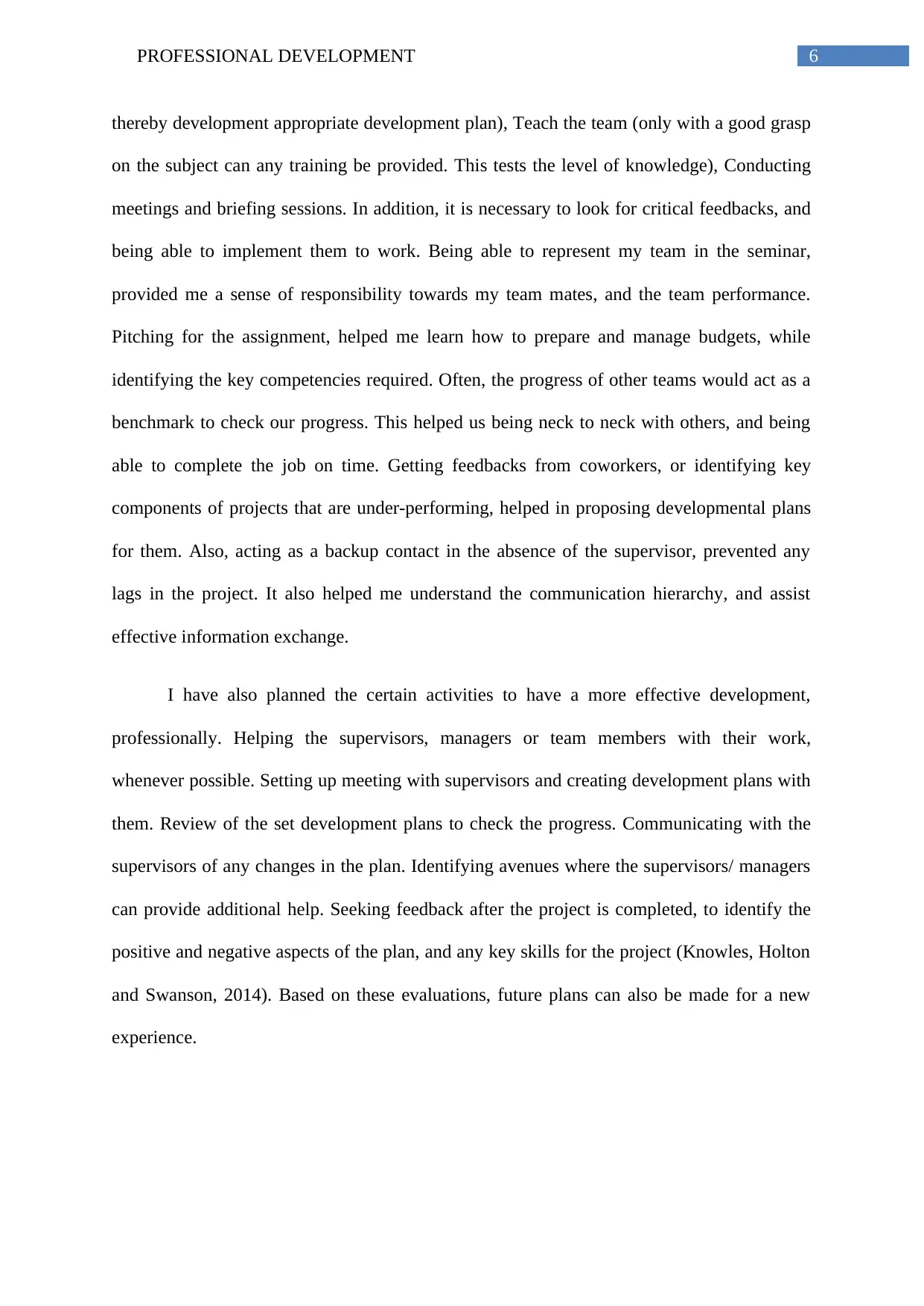
6PROFESSIONAL DEVELOPMENT
thereby development appropriate development plan), Teach the team (only with a good grasp
on the subject can any training be provided. This tests the level of knowledge), Conducting
meetings and briefing sessions. In addition, it is necessary to look for critical feedbacks, and
being able to implement them to work. Being able to represent my team in the seminar,
provided me a sense of responsibility towards my team mates, and the team performance.
Pitching for the assignment, helped me learn how to prepare and manage budgets, while
identifying the key competencies required. Often, the progress of other teams would act as a
benchmark to check our progress. This helped us being neck to neck with others, and being
able to complete the job on time. Getting feedbacks from coworkers, or identifying key
components of projects that are under-performing, helped in proposing developmental plans
for them. Also, acting as a backup contact in the absence of the supervisor, prevented any
lags in the project. It also helped me understand the communication hierarchy, and assist
effective information exchange.
I have also planned the certain activities to have a more effective development,
professionally. Helping the supervisors, managers or team members with their work,
whenever possible. Setting up meeting with supervisors and creating development plans with
them. Review of the set development plans to check the progress. Communicating with the
supervisors of any changes in the plan. Identifying avenues where the supervisors/ managers
can provide additional help. Seeking feedback after the project is completed, to identify the
positive and negative aspects of the plan, and any key skills for the project (Knowles, Holton
and Swanson, 2014). Based on these evaluations, future plans can also be made for a new
experience.
thereby development appropriate development plan), Teach the team (only with a good grasp
on the subject can any training be provided. This tests the level of knowledge), Conducting
meetings and briefing sessions. In addition, it is necessary to look for critical feedbacks, and
being able to implement them to work. Being able to represent my team in the seminar,
provided me a sense of responsibility towards my team mates, and the team performance.
Pitching for the assignment, helped me learn how to prepare and manage budgets, while
identifying the key competencies required. Often, the progress of other teams would act as a
benchmark to check our progress. This helped us being neck to neck with others, and being
able to complete the job on time. Getting feedbacks from coworkers, or identifying key
components of projects that are under-performing, helped in proposing developmental plans
for them. Also, acting as a backup contact in the absence of the supervisor, prevented any
lags in the project. It also helped me understand the communication hierarchy, and assist
effective information exchange.
I have also planned the certain activities to have a more effective development,
professionally. Helping the supervisors, managers or team members with their work,
whenever possible. Setting up meeting with supervisors and creating development plans with
them. Review of the set development plans to check the progress. Communicating with the
supervisors of any changes in the plan. Identifying avenues where the supervisors/ managers
can provide additional help. Seeking feedback after the project is completed, to identify the
positive and negative aspects of the plan, and any key skills for the project (Knowles, Holton
and Swanson, 2014). Based on these evaluations, future plans can also be made for a new
experience.
Paraphrase This Document
Need a fresh take? Get an instant paraphrase of this document with our AI Paraphraser
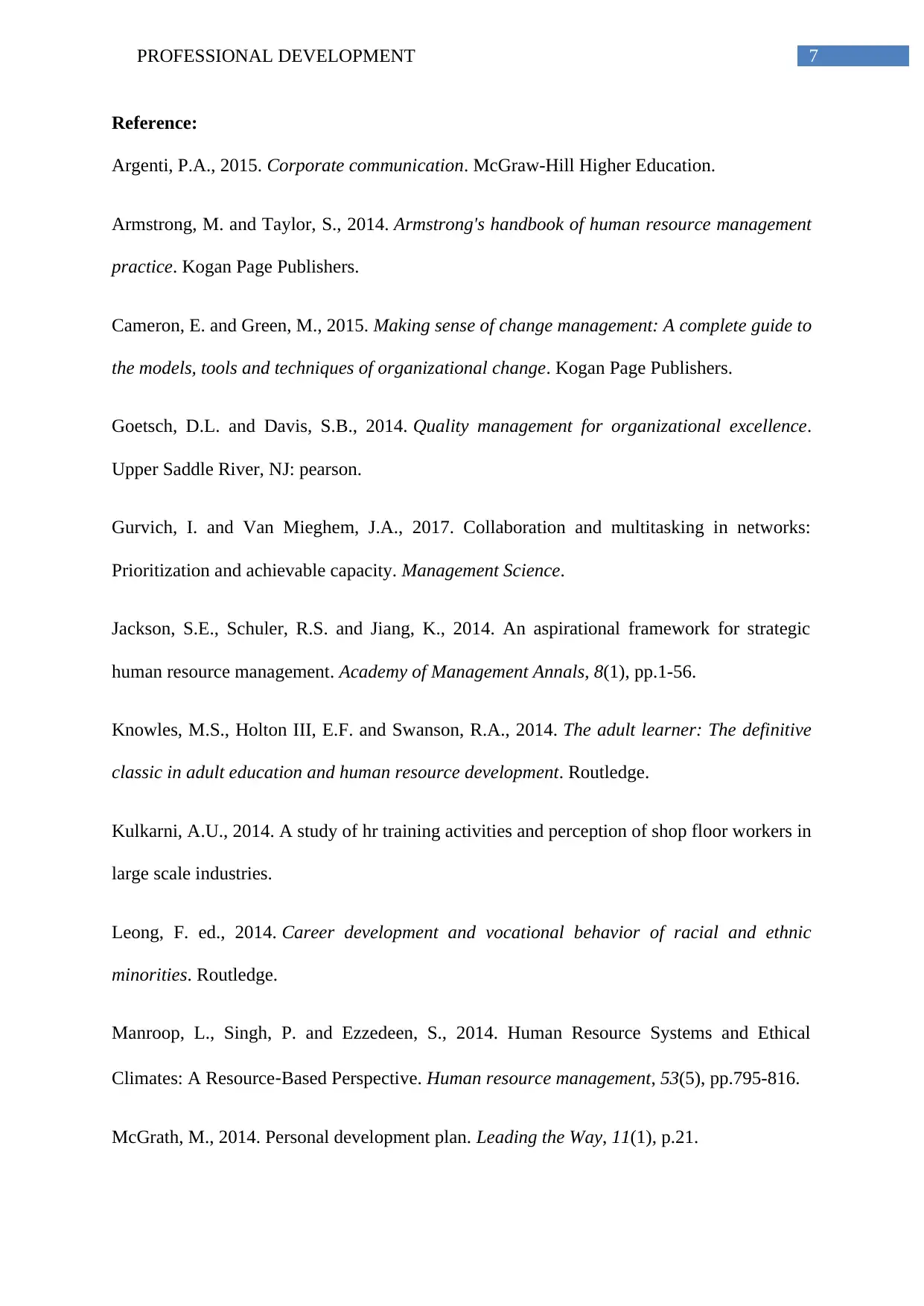
7PROFESSIONAL DEVELOPMENT
Reference:
Argenti, P.A., 2015. Corporate communication. McGraw-Hill Higher Education.
Armstrong, M. and Taylor, S., 2014. Armstrong's handbook of human resource management
practice. Kogan Page Publishers.
Cameron, E. and Green, M., 2015. Making sense of change management: A complete guide to
the models, tools and techniques of organizational change. Kogan Page Publishers.
Goetsch, D.L. and Davis, S.B., 2014. Quality management for organizational excellence.
Upper Saddle River, NJ: pearson.
Gurvich, I. and Van Mieghem, J.A., 2017. Collaboration and multitasking in networks:
Prioritization and achievable capacity. Management Science.
Jackson, S.E., Schuler, R.S. and Jiang, K., 2014. An aspirational framework for strategic
human resource management. Academy of Management Annals, 8(1), pp.1-56.
Knowles, M.S., Holton III, E.F. and Swanson, R.A., 2014. The adult learner: The definitive
classic in adult education and human resource development. Routledge.
Kulkarni, A.U., 2014. A study of hr training activities and perception of shop floor workers in
large scale industries.
Leong, F. ed., 2014. Career development and vocational behavior of racial and ethnic
minorities. Routledge.
Manroop, L., Singh, P. and Ezzedeen, S., 2014. Human Resource Systems and Ethical
Climates: A Resource‐Based Perspective. Human resource management, 53(5), pp.795-816.
McGrath, M., 2014. Personal development plan. Leading the Way, 11(1), p.21.
Reference:
Argenti, P.A., 2015. Corporate communication. McGraw-Hill Higher Education.
Armstrong, M. and Taylor, S., 2014. Armstrong's handbook of human resource management
practice. Kogan Page Publishers.
Cameron, E. and Green, M., 2015. Making sense of change management: A complete guide to
the models, tools and techniques of organizational change. Kogan Page Publishers.
Goetsch, D.L. and Davis, S.B., 2014. Quality management for organizational excellence.
Upper Saddle River, NJ: pearson.
Gurvich, I. and Van Mieghem, J.A., 2017. Collaboration and multitasking in networks:
Prioritization and achievable capacity. Management Science.
Jackson, S.E., Schuler, R.S. and Jiang, K., 2014. An aspirational framework for strategic
human resource management. Academy of Management Annals, 8(1), pp.1-56.
Knowles, M.S., Holton III, E.F. and Swanson, R.A., 2014. The adult learner: The definitive
classic in adult education and human resource development. Routledge.
Kulkarni, A.U., 2014. A study of hr training activities and perception of shop floor workers in
large scale industries.
Leong, F. ed., 2014. Career development and vocational behavior of racial and ethnic
minorities. Routledge.
Manroop, L., Singh, P. and Ezzedeen, S., 2014. Human Resource Systems and Ethical
Climates: A Resource‐Based Perspective. Human resource management, 53(5), pp.795-816.
McGrath, M., 2014. Personal development plan. Leading the Way, 11(1), p.21.
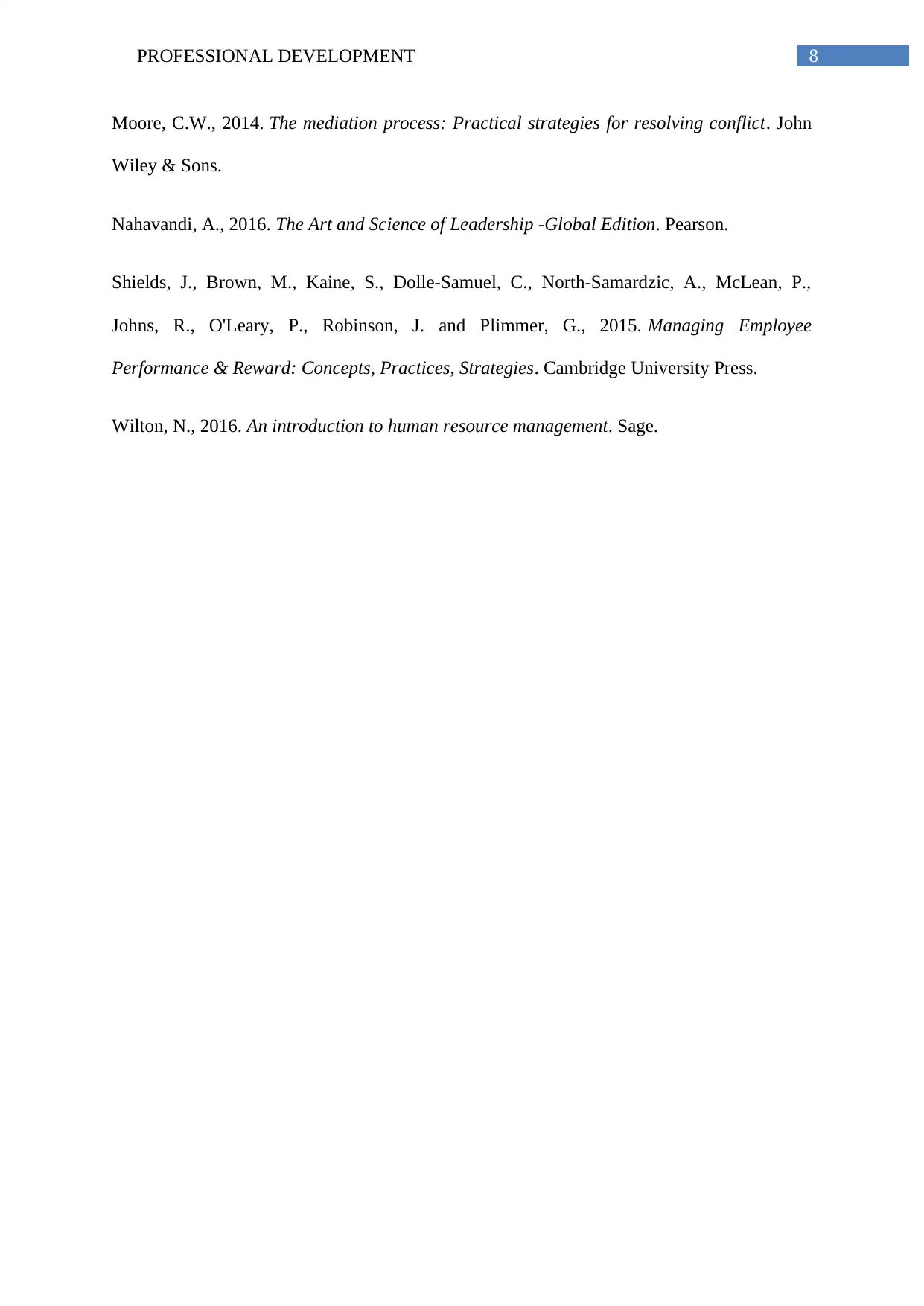
8PROFESSIONAL DEVELOPMENT
Moore, C.W., 2014. The mediation process: Practical strategies for resolving conflict. John
Wiley & Sons.
Nahavandi, A., 2016. The Art and Science of Leadership -Global Edition. Pearson.
Shields, J., Brown, M., Kaine, S., Dolle-Samuel, C., North-Samardzic, A., McLean, P.,
Johns, R., O'Leary, P., Robinson, J. and Plimmer, G., 2015. Managing Employee
Performance & Reward: Concepts, Practices, Strategies. Cambridge University Press.
Wilton, N., 2016. An introduction to human resource management. Sage.
Moore, C.W., 2014. The mediation process: Practical strategies for resolving conflict. John
Wiley & Sons.
Nahavandi, A., 2016. The Art and Science of Leadership -Global Edition. Pearson.
Shields, J., Brown, M., Kaine, S., Dolle-Samuel, C., North-Samardzic, A., McLean, P.,
Johns, R., O'Leary, P., Robinson, J. and Plimmer, G., 2015. Managing Employee
Performance & Reward: Concepts, Practices, Strategies. Cambridge University Press.
Wilton, N., 2016. An introduction to human resource management. Sage.
⊘ This is a preview!⊘
Do you want full access?
Subscribe today to unlock all pages.

Trusted by 1+ million students worldwide
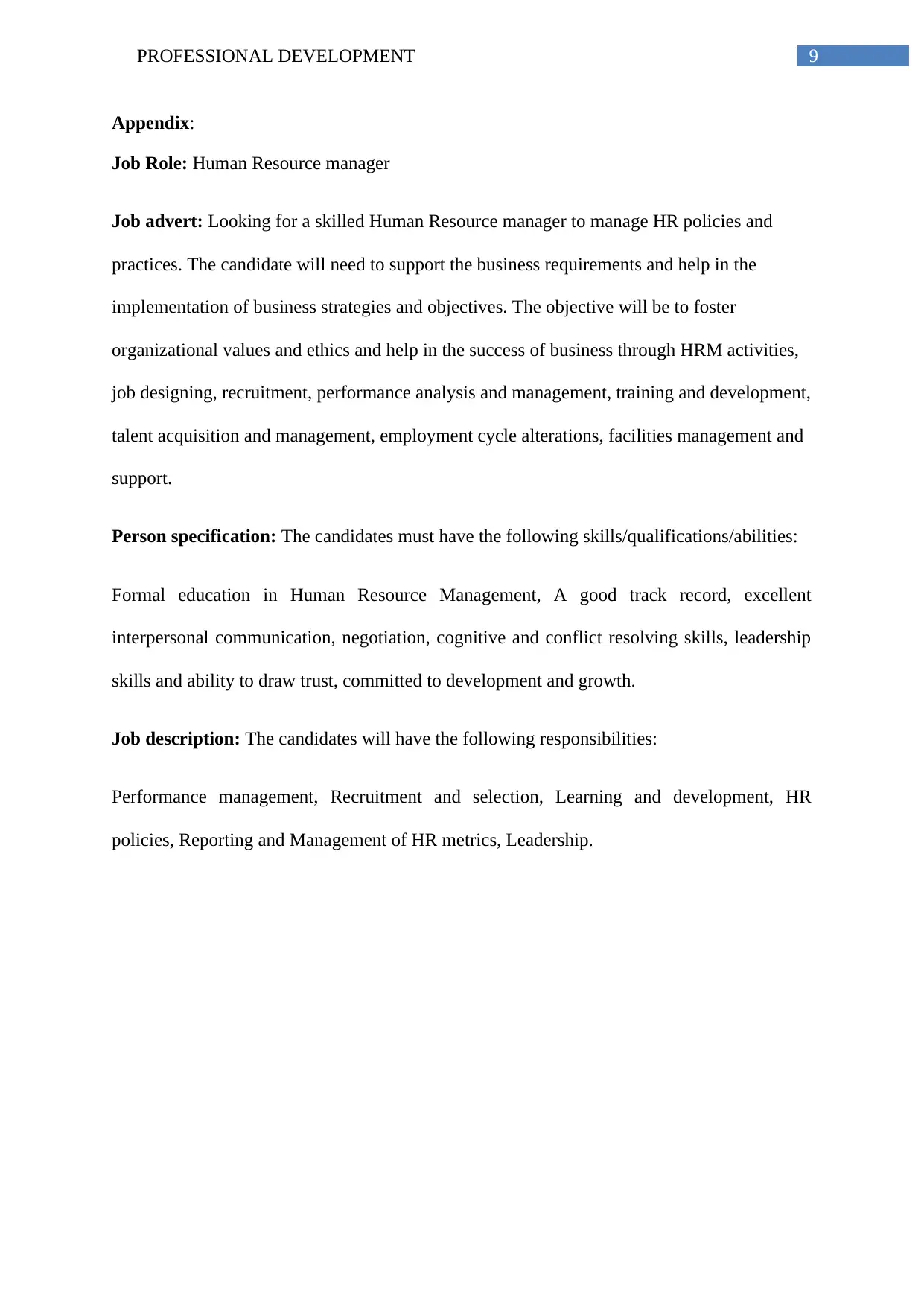
9PROFESSIONAL DEVELOPMENT
Appendix:
Job Role: Human Resource manager
Job advert: Looking for a skilled Human Resource manager to manage HR policies and
practices. The candidate will need to support the business requirements and help in the
implementation of business strategies and objectives. The objective will be to foster
organizational values and ethics and help in the success of business through HRM activities,
job designing, recruitment, performance analysis and management, training and development,
talent acquisition and management, employment cycle alterations, facilities management and
support.
Person specification: The candidates must have the following skills/qualifications/abilities:
Formal education in Human Resource Management, A good track record, excellent
interpersonal communication, negotiation, cognitive and conflict resolving skills, leadership
skills and ability to draw trust, committed to development and growth.
Job description: The candidates will have the following responsibilities:
Performance management, Recruitment and selection, Learning and development, HR
policies, Reporting and Management of HR metrics, Leadership.
Appendix:
Job Role: Human Resource manager
Job advert: Looking for a skilled Human Resource manager to manage HR policies and
practices. The candidate will need to support the business requirements and help in the
implementation of business strategies and objectives. The objective will be to foster
organizational values and ethics and help in the success of business through HRM activities,
job designing, recruitment, performance analysis and management, training and development,
talent acquisition and management, employment cycle alterations, facilities management and
support.
Person specification: The candidates must have the following skills/qualifications/abilities:
Formal education in Human Resource Management, A good track record, excellent
interpersonal communication, negotiation, cognitive and conflict resolving skills, leadership
skills and ability to draw trust, committed to development and growth.
Job description: The candidates will have the following responsibilities:
Performance management, Recruitment and selection, Learning and development, HR
policies, Reporting and Management of HR metrics, Leadership.
1 out of 10
Related Documents
Your All-in-One AI-Powered Toolkit for Academic Success.
+13062052269
info@desklib.com
Available 24*7 on WhatsApp / Email
![[object Object]](/_next/static/media/star-bottom.7253800d.svg)
Unlock your academic potential
Copyright © 2020–2025 A2Z Services. All Rights Reserved. Developed and managed by ZUCOL.





